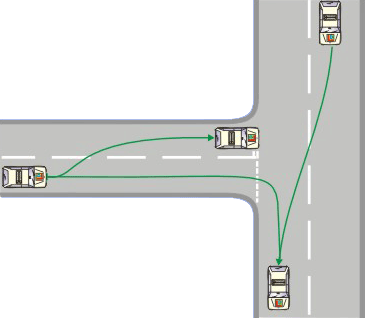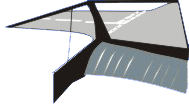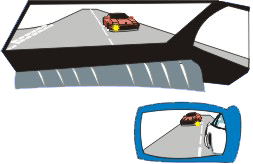Learn to Drive
Driving lesson brief M3. Reversing to the right
Introduction
Once you have mastered the skill of reversing round a corner or into a parking bay on your left it’s time for you to learn how to do this from the right. These lessons can often be combined because of the similarity between the two skills. The main difference being that the kerb is on your right hand side, which requires you to alternate between looking over your left and your right hand shoulder.
![]() Lesson objectives
Lesson objectives
By the end of this lesson you should be able to:
- Explain when it would not be safe, legal or convenient to carry out this manoeuvre
- Explain the dangers caused by the car as you start to turn
- Pull up in a suitable position on the right hand side of the road just after the side road into which you intend to reverse, timing your signal correctly
- Judge when you should begin to turn depending on the sharpness of the corner
- Correctly switch your seating position and the position of your hands to take observations to the rear over your right shoulder as you negotiate the corner
- Make suitable all round observational checks throughout the manoeuvre and especially before you turn, ensuring it is safe to proceed
- Steer a suitable course as you turn and keep within a metre of the kerb or less if the road is narrow or within the parking bay lines when parking
- Judge when you should begin to straighten up your steering as you enter the side road or parking bay
- Correct positioning errors
- Deal correctly with other road users
- Recognise when you have reversed far enough into the side road to enable you to safely move off from the right hand side of the road
- Remember to fasten your seat belt then move off safely from the right hand side of the road
- Complete the exercise on sharp and curved corners on roads with varying gradients
Lesson Brief
 It is often said that reversing to the right is useful when driving a van or similar vehicle. This is because the view to the rear left (i.e. nearside) is restricted. Vans aren't the only vehicles that are affected by this problem. Many modern sports cars have severely restricted rear vision.
It is often said that reversing to the right is useful when driving a van or similar vehicle. This is because the view to the rear left (i.e. nearside) is restricted. Vans aren't the only vehicles that are affected by this problem. Many modern sports cars have severely restricted rear vision.
Unlike the reverse to the left you do not have the problem of reversing against the flow of traffic. However, you are facing the wrong direction and will potentially cause problems for traffic turning into the side road from the major road.
The additional learning points that you need to consider with this manoeuvre are:
 Seating and hand position
Seating and hand position
When reversing to the right while negotiating the corner you would need to turn in your seat slightly to the right so that you can look over your right hand shoulder. Your hand position would also switch so that you
corner you would need to turn in your seat slightly to the right so that you can look over your right hand shoulder. Your hand position would also switch so that you
 could use the pull-push method of steering.
could use the pull-push method of steering.
The seating and hand position when not negotiating the corner would be the same as when you were reversing in a straight line.
- All round awareness
 You would need to take extra care to watch for vehicles from behind that want to turn into the side road. Check through your left (nearside) door mirror and over your left shoulder as necessary. Similarly you would need to particularly watch for oncoming traffic that wants to turn into the side road. As you turn the front of your vehicle will swing out therefore you need to consider whether this will present a hazard to passing traffic on the major road.
You would need to take extra care to watch for vehicles from behind that want to turn into the side road. Check through your left (nearside) door mirror and over your left shoulder as necessary. Similarly you would need to particularly watch for oncoming traffic that wants to turn into the side road. As you turn the front of your vehicle will swing out therefore you need to consider whether this will present a hazard to passing traffic on the major road.

- Dealing with other road users.
You must always be prepared to wait for oncoming traffic to pass. However, you may sometimes find that oncoming traffic turning into the side road decide to wait for you in which case you would have to continue with the manoeuvre. You will also need to wait for the vehicles approaching from behind if they intend to turn into the side road or if you are at the point just before you propose to turn knowing that your front end will swing into their path. - Distance you need to reverse into the side road
To prevent a potential head on collision with traffic turning into the side road it is important that you reverse sufficiently far enough back to give them sufficient room to stop and overtake you safely. You also need sufficient room to ensure that you will not become a potential hazard to them as you cross over to the left hand lane. Also before moving off you would need to check over your left shoulder.